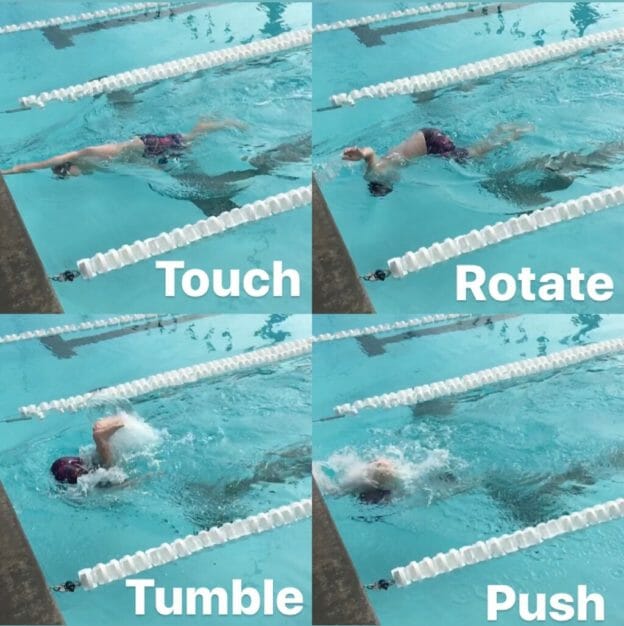 |
It is important to learn the crossover transition to improve your technique in the individual medley. |
Learning the Crossover Transition
There are four Swimming Techniques for the Individual Medley to make a transition from backstroke to breaststroke in the individual medley. They are the open turn, reverse flip, bucket turn, and the crossover transition. Most of the elite swimmers today use the crossover transition. It offers three clear advantages over the other techniques.

Advantage over the Open Turn
- In the open turn, the swimmer reaches back, blindly waiting for the hand to touch the wall before reacting. The transition is made by reversing direction with the head rising above the water for a final breath before the breaststroke pullout. It is slower and does not conform to the law of inertia. It does allow the swimmer to get a late breath before the pullout. The open turn is a more appropriate technique for the 400 IM than for the shorter IM events. However, many elite swimmers use the crossover transition for all individual medley events.
Advantage over the Reverse Flip
- The reverse flip is used by some swimmers. When the swimmer reaches back to the wall blindly, the head is allowed to submerge. Once the hand touches the wall, the feet go directly over the top in a vertical plane. The swimmer ends up on the stomach and pushes off into the pullout. The two disadvantages of this technique are that it is disorienting, and water can easily go up the nose into the sinuses, a very uncomfortable problem.
Advantage over the Bucket Turn
- The bucket turn is rarely used today. It is basically an open turn, but rather than tucking the legs under the water, the swimmer draws them above the water and swings them to the side in order to make the turn. Like the open turn, this transition is slow and cumbersome.
Advantage of Using the Crossover Transition
- The crossover transition is similar to the backstroke flip turn technique. The three advantages of the crossover transition are the following:
-
- It is the only technique that enables the swimmer to see the wall before he/she touches it. The swimmer can then anticipate precisely when the transition will happen.
- By reaching overhead on one’s side, the swimmer can extend the arm further and reach the wall sooner than with the other transitions.
- It conforms better to the law of inertia by following the same pathway, rather than requiring a reversal of direction.
These 3 advantages make the crossover transition faster and more efficient than the other 3 techniques. The two disadvantages of the crossover transition are that the swimmer takes the last breath slightly sooner than with the open turns. It also requires a lot of practice to get it right. Many swimmers get disqualified during the early learning of this technique.
If you try to learn how to do the crossover transition by watching the elite individual medley swimmers perform it in competition, good luck. All you will see is a big splash of water, and they are gone. Afterward, you will find yourself scratching your head, wondering what just happened?
Recommendations
Instead, I recommend you check out our latest Race Club video on 5 Easy Steps to Learn the Crossover Transition. We’ve made this video available to everyone. After years of teaching this technique, I have finally figured out the best way to teach the crossover transition. Any swimmer can learn to do it in 30 minutes or less.
For those of you subscribing to Lanes 2, 3, or 4, you will also find another video breaking down the first step of learning this technique. In this video, we highlight some of the most common mistakes made in initiating the crossover transition.
Just remember our rule of 100. Once you get the crossover transition down legally, practice it 100 times before you perform it in competition. If you want to learn to do it well with both hands, you’ll need to practice it at least 500 times before you are ready. The non-dominant arm always takes longer to learn than the dominant arm.
If you want to swim a fast individual medley, learn the crossover transition today.
At what age do you think young swimmers can begin using the crossover turn?
Yours in swimming,
Gary Sr.

